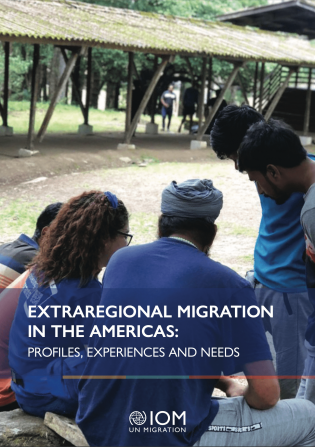Extraregional Migration in the Americas: Profiles, Experiences and Needs

IOM, through the Western Hemisphere Regional Migration Capacity-Building Program covering Mesoamerica and the Caribbean, has developed this study in order to provide an updated description of extraregional migration across the Americas.
BACKGROUND:
The number of extraregional migrants from Africa, Asia and the Caribbean in Mesoamerica – Central America and Mexico – has increased in recent years. These migrants tend to use both regular means of entry as well as routes associated with smuggling of migrants and irregular border crossing points;
Information on extraregional migrants is scarce, as it is difficult to gain access to this population. Available documentation focuses on two aspects: describing extraregional migrant groups and mapping their main travel routes to the United States and Canada; and
The purpose of this report is to describe the main experiences and needs of a group of over 350 extraregional migrants across three sections of their migration route: South America, Central America and Mexico.
MAIN FINDINGS
- Population description: The extra-regional migrants interviewed were between 18 and 35 years old, mainly men, and had varying levels of education. However, 22 per cent of women and 9 per cent of men travelled with children under 18. The primary places of origin were Caribbean countries, such as Haiti and Cuba; African countries, like Cameroon and the Democratic Republic of the Congo; and Asian countries, including India and Nepal;
- Route followed: Most interviewees followed a route that began in South America, particularly in Brazil, Ecuador, or Chile; they then travelled through Colombia, Panama, Costa Rica, Nicaragua, Honduras, and Guatemala, finally arriving in Mexico;
- Access to services and information: Access was limited for the migrants, especially with regard to accurate route details, information on migration management processes in each country and medical and financial services. However, many transit communities lacked these services. In addition, language barriers and the spread of false information were important obstacles;
- Factors contributing to vulnerability: Multiple factors contributing to the migrants’ vulnerability were identified, such as language barriers; lack of housing, food and medical care; and difficulties in obtaining temporary employment;
- Border experience: Migrants passing by official border crossing points had to follow the established procedures of each country, however, many groups crossed various borders irregularly, paying third parties to help them. immigration management; and
- Social inclusion: Social inclusion in transit countries was reported as being difficult for most of the population, mainly due to language and cultural barriers.
IDENTIFIED NEEDS AND RECOMMENDATIONS
The findings and recommendations of this study are consistent with IOM’s Plan to strengthen the governance of extraregional migrant flows in Mesoamerica. This report highlights the importance of implementing the following recommendations:
- Encourage the development of initiatives to facilitate access to clear and reliable information on migration processes and routes;
- Strengthen security mechanisms for migrants in order to reduce their risk of exposure to theft and scams;
- Facilitate access to psychosocial care, especially after passing through the Darien Gap;
- Promote community actions to offer nutritional and culturally appropriate meal options for the extraregional population, especially for migrants from Asia and Africa;
- Provide accommodation options that meet the specific needs of each population on the northern border of Mexico for all that require them;
- Improve the delivery of health services for the local and extraregional migrant populations, especially water distribution;
- Develop mechanisms in transit countries to regularize access to temporary employment for extraregional migrants;
- Create Spanish language-learning programmes, especially for the Haitian population; and
- Train border authorities in the English language.